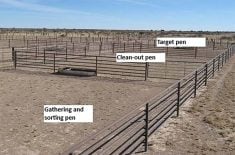Septic arthritis is a joint infection that can affect cattle of any age but is a particular problem in neonates. It is expensive to treat and the outcome is not always positive.
Bacteria invade the joint in one of four ways:
- Something penetrating the joint such as a wood sliver or prong of barbed wire can carry bacteria in with it.
- An existing infection in a nearby bone or in the overlying skin, such as a foot rot infection, can extend down into the joint. No trauma is required; the bacteria seeps through the tissues into the joint.
- Occurring most often in newborns, bacteria from infections anywhere in the body such as pneumonia or umbilical infections enter the bloodstream. This immediately creates a septicemia, or infection in the blood. Normally, circulating white blood cells kill these bacteria, but in some cases the infection is so severe that it overwhelms the immune system. The bacteria circulate and end up everywhere, including the joints.
- Septic arthritis can be a consequence of dirty injection techniques. For example, when a veterinarian puts a needle into a joint to sample the fluid or when he injects medication into a joint, bacteria from dirty skin can be carried in with the needle.
Read Also

Beef cattle more prone to trace mineral deficiencies
The trace mineral status of our cows and calves is a significant challenge for western Canadian producers and veterinarians.
Once in the nutritious joint fluid, bacteria thrive and readily multiply because the immune system has difficulty controlling infections in joints. The bacteria produce toxins that incite an inflammatory response, which is recognized by swelling and pain.
If a producer is an astute observer, he may notice the first sign of septic arthritis: joint swelling. This is due to a buildup of pus in the joint and inflammation in the tissues surrounding the joint. Unfortunately, this stage is usually missed.
As the disease progresses, the animal becomes lame and the diagnosis is more obvious. The joint becomes warm to the touch, obviously swollen and painful if manipulated.
It’s useful, though not always practical, to X-ray septic joints to see how healthy they are. If significant bone destruction is evident on the X-ray, it suggests chronic, advanced disease and getting the infection under control will be difficult.
Infectious arthritis can be confirmed by analyzing joint fluid, which is obtained by inserting a needle in the joint and withdrawing a sample. Some veterinarians also culture the fluid to determine which bacteria are involved. This also pins down the most appropriate antibiotic to use.
To treat septic arthritis, veterinarians follow three principles: control the infection; remove abnormal joint fluid and stop the inflammation.
Antibiotics are the first line of defence against joint infections, specifically a broad spectrum injectable antibiotic. It is given at the high end of the dose range for two weeks beyond clinical improve-ment. An alternative is injecting antibiotics directly into the joint.
Infected joint fluid can be removed by lavage, or flushing the joint. To do this, two large needles are inserted into the joint. One is connected to a syringe or intravenous line to inject fluids, while the other allows the fluid to drain out. Large volumes of 250 cc or more are injected in one treatment. The procedure is done daily for five days or until the fluid exiting the joint starts to clear.
Unfortunately, because lavage is a painful procedure and the joint must be kept still while it’s being done, general anesthesia is normally required, which makes lavage an expensive treatment.
To control the pain, flunixin or ketoprofen is administered to reduce inflammation and make the animal feel better.
If these methods fail, a salvage procedure that can be tried is an arthrotomy. Under anesthetic, the joint is opened surgically to allow a thorough cleaning. This is done as a stop-gap measure to get the animal to slaughter.














